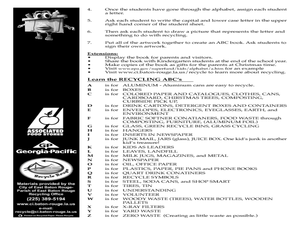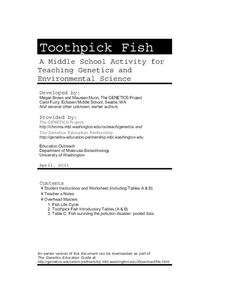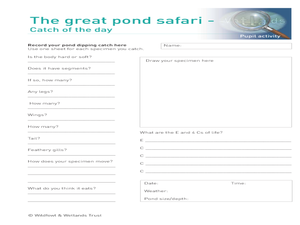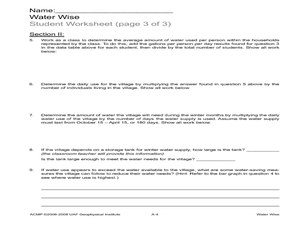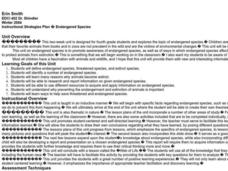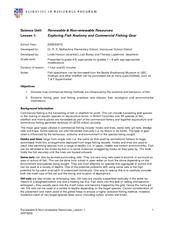Cold Spring Harbor Laboratory
Some Types of Mutations Are Automatically Repaired
Does natural light damage or repair DNA? Learn the answer discover the scientists who researched the topic with an online interactive. Scholars read through an online animation presenting the content at their own pace. Then, they read...
Curated OER
The Chesapeake Bay in Captain John Smith's Time
When Captain John Smith visited the Chesapeake Bay in the summer of 1608, what types of animals and habitats did he encounter? Your young historians will analyze primary source documents to answer this question, as well as compare...
Curated OER
Exploring Ecosystems
Students examine the relationships between plants, animals, and the environment in ecosystems. They sort animal cards, collect natural materials from the schoolyard, and record an ecosystem web in the form of a poster.
Curated OER
The Great Kapok Tree by Lynne Cherry
With The Great Kapok Tree, by Lynne Cherry as the hook learners discuss the rainforest, the animals that live there, and conservation efforts. Then, students write a letter to the man in the story asking him not to cut down the Kapok...
Curated OER
The Recycle Alphabet
First graders recognize words associated with recycling. In this environmental lesson, 1st graders go through the alphabet and think of words associated with recycling that start with a letter. Students create a recycling ABC book.
University of Washington
Toothpick Fish
With colored toothpicks representing genes, youngsters practice passing them through generations of fish and learn about heredity. Consider this as an introductory activity since it does not represent recessive genes with lowercase...
Curated OER
Recycling: The Way to Save...Fad or Fact
Students write stories about recycling and illustrate them. They examine various containers and determine whether or not they are recyclable. They make a chart about the containers and visit a recycling center.
Curated OER
Changes Over Time
Sixth graders identify and classify changes in their lives. During the second lesson students record observations of Blue Palo Verde seed pods and predict changes over time leading to further investigations.
Curated OER
Pond Safari
Students investigate organisms and animals by examining a nearby pond. For this ecosystem lesson, students participate in a field trip to a local pond where they utilize a net to gather animals, plants and pollution items, Students...
Curated OER
Renewable Resources: Ancient Civilizations
Students examine how ancient people used natural resources. For this renewable resource lesson, students will be put into 5 groups each focusing on a different past civilization. Each group will identify they types of resources their...
Curated OER
Water Wise
Students calculate their family's water consumption. In this water usage lesson, students discuss the water they use in their homes. Students complete the 'water wise' worksheets to tally their family's use of water. Students answer...
Curated OER
Water and Sanitation
Learners examine water contamination problems. In this global studies lesson, students compare and contrast water sanitation issues on Malawi, Tanzania, and Ontario. Learners propose solutions to the water sanitation problems.
Curated OER
Invasive Species
Students study exotic and native species, and examine how exotic species can impact native ones. They study how the mute swan effects native species.
Curated OER
Working Animals
Young scholars examine the need for the humane treatment of animals. In this animal welfare lesson, students realize the need for animal welfare, and decide on a service project that will promote it. The lesson culminates in the creation...
Curated OER
Biomimicry: Working Together, Cooperative Design
Students explore the concept of biomimicry. In this cooperative design lesson, students consider how cooperation is connected to nature and then collaborate to create their own cooperative designs for the future.
Curated OER
Endangered Species
Fourth graders investigate endangered species to discover reasons for the extinction. Resources are examined to determine preventive measures for the endangerment. The unit contains four lessons.
Curated OER
Make a Statement!
Students discuss a class collection of bumper stickers dealing with an environmental issue. They discuss whether or not the bumper sticker have a positive effect or could change a person's viewpoiint.
Curated OER
The Very Hungry Caterpillar
Second graders watch a video about Eric Carle before listening to his story entitled, The Very Hungry Caterpillar. They notice how the caterpillar eats its way through the days of the week and they examine the life cycle of the...
Curated OER
Exploring Fish Anatomy and Commercial Fishing Gear
Students investigate commercial fishing by exploring the technical methods. In this environmental lesson, students identify the fish that are most commonly consumed by humans and trace their path from ocean to plate. Students...
Curated OER
Analyzing The Research Of The Earth
High schoolers investigate the concept of technology. They are taught about various science applications and how the technology is used in the disciplines. Students pick a subject to research and then indicate the technologies related to...
Curated OER
How Evolution Works
High schoolers discuss the evolution of the eye and how a complex organ can evolve through natural selection. They research genetic variation, adaptation, and sexual selection. They analyze data to determine how beak length of Gal??pagos...
Curated OER
Biomes
Students collect information about different biomes, and locate the biomes on a world map. They read a climograph and match them to the appropriate biomes.
Curated OER
Control of the Cell Cycle
In this cell cycle worksheet, students review how enzymes control the cell cycle and what happens when the cell cycle becomes uncontrolled. This worksheet has 7 short answer questions.
Curated OER
Seed Germination
Young scholars germinate a Mung Bean seed. In this seed lesson students conduct an experiment germinating a Mung Bean. They apply three different treatments to the seeds: dry, moist, and underwater incubation.






